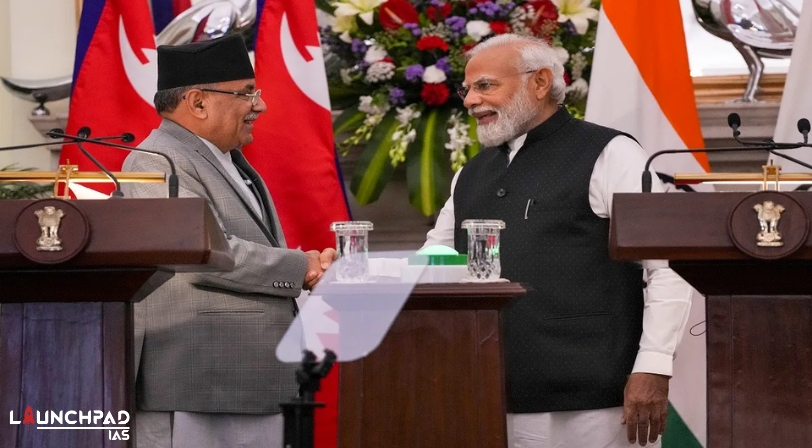How have the Historical Ties been?
- Nepal is an important neighbor of India and occupies a special significance in its foreign policy because of the geographic, historical, cultural, and economic linkages/ties that span centuries.
- India and Nepal share similar ties in terms of Hinduism and Buddhism with Buddha’s birthplace Lumbini located in present-day Nepal.
- The two countries not only share an open border and unhindered movement of people, but they also have close bonds through marriages and familial ties, popularly known as Roti-Beti ka Rishta.
- The India-Nepal Treaty of Peace and Friendship of 1950 forms the bedrock of the special relations that exist between India and Nepal.
What is the Treaty of Peace and Friendship of 1950?
- The treaty talks about the reciprocal treatment of Indian and Nepali citizens in the two countries, in residence, property, business, and movement.
- It also establishes national treatment for both Indian and Nepalese businesses (i.e., once imported, foreign goods would be treated no differently than domestic goods).
- It also gives Nepal access to weaponry from India.
Current Status of Ties
Power Sector Cooperation:
Long-Term Power Trade Agreement: India and Nepal signed a long-term Power Trade Agreement, targeting the import of 10,000 MW of electricity from Nepal in the coming years.
Hydropower Projects:
Memoranda of Understanding (MoUs) were signed between the National Hydroelectric Power Corporation (NHPC), India, and Vidyut Utpadan Company Ltd, Nepal for the development of the Phukot Karnali Hydroelectric Project and the Lower Arun Hydroelectric Project.
Also, both countries expressed their commitment to achieving tangible and time-bound progress on the Pancheshwar multipurpose project, which aims to enhance cooperation in harnessing the shared water resources of the Mahakali River.
Transport Development:
- Transmission Line and Rail Link: The groundbreaking ceremony for the Gorakhpur-Bhutwal Transmission Line and the inauguration of the Indian Railway cargo train from Bathnaha to Nepal Customs Yard highlighted the focus on enhancing connectivity between the two countries.
- Integrated Checkposts (ICPs): ICPs were inaugurated at Nepalgunj (Nepal) and Rupaidiha (India), promoting smoother cross-border trade and facilitating the movement of goods and people.
Defence Cooperation:
- Bilateral defence cooperation includes assistance to the Nepalese Army in its modernization through the provision of equipment and training.
- The Gorkha Regiments of the Indian Army are raised partly by recruitment from hill districts of Nepal.
- India from 2011, every year undertakes a joint military exercise with Nepal known as Surya Kiran.
Cultural:
- There have been initiatives to promote people-to-people contacts in the area of art & culture, academics, and media with different local bodies of Nepal.
- India has signed three sister-city agreements for the twinning of Kathmandu-Varanasi, Lumbini-Bodhgaya, and Janakpur-Ayodhya.
Humanitarian Assistance:
Nepal lies in the sensitive ecological fragile zone which is prone to earthquakes and floods causing massive damage to both life and money, whereby it remains the biggest recipient of India’s humanitarian assistance.
Setting up a Satellite Campus:
India has offered to set up a satellite campus of the Indian Institute of Technology (IIT) in Rupandehi and has sent some draft memoranda of understanding for signing between Indian and Nepali universities.
Other Initiatives:
- A plan to extend South Asia’s first cross-border petroleum pipeline from Motihari in India to Amlekhgunj in Nepal by another 69 km up to Chitwan in Nepal.
- Also, a second cross-border petroleum pipeline from Siliguri in India to Jhapa in eastern Nepal.
- A revised Treaty of Transit signed on June 1, 2023, that will give Nepal access to India’s inland waterways.
- This will enable Nepal to use Indian ports such as Haldia, Kolkata, Paradip, and Visakhapatnam for its third-country trade.
- It will also reduce transportation costs and time for Nepalese exporters and importers.
- India is also cooperating with Nepal to set up a fertilizer plant, emphasizing the importance of collaboration in the agricultural sector
Challenges in India-Nepal Relationship
- Issues with Peace and Friendship Treaty: The 1950 Treaty of Peace and Friendship between India and Nepal guaranteed Nepali citizens free movement across the border and employment opportunities in India. However, some perceive this treaty as unequal and imposed by India.
- Territorial Disputes: Certain areas along the India-Nepal boundary, such as Kalapani, have remained unresolved. Nepal claims these territories as part of its own, while India inherited them from British colonial rule.
- Chinese Interference: In recent years, Nepal has been moving away from India’s influence and China has been stepping in with investments, aid, and loans. China’s involvement in Nepal’s infrastructure projects through its Belt and Road Initiative poses a threat to Nepal’s role as a buffer state between India and China.
- Security Threat: The porous and poorly guarded border between India and Nepal allows terrorist groups to exploit it for smuggling weapons, ammunition, trained members, and fake currency, which poses a significant security risk to India.
- Trust Deficit: The trust between India and Nepal has weakened over time due to India’s slow implementation of projects. Some Nepalese ethnic groups feel that India interferes too much in Nepal’s politics and undermines their political independence, leading to a dislike for India.


